Brew a primitive mugwort lemon beer with foraged ingredients. This home brew is easy to make and so delicious! Mugwort is easy to forage for, smells delicious, and is a great herb to use in a homemade beer recipe
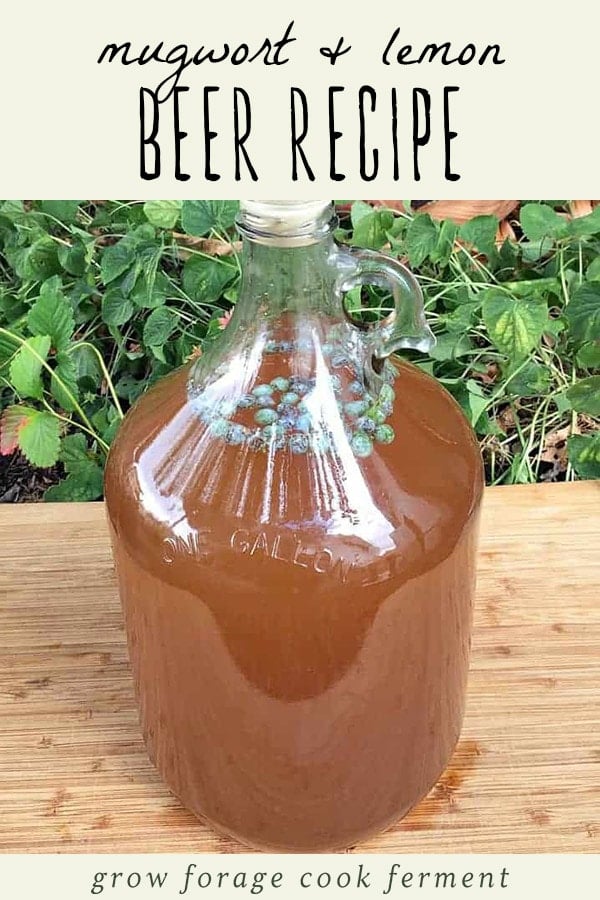
Want to save this post for later?
Homemade Herbal Brewing
You may remember several weeks ago that I made a starter from wild yeast. Once it was bubbling along nicely, I wanted to use it in something (of course).
Since I got the wild yeast recipe from Pascal Baudar’s book The New Wildcrafted Cuisine, I decided to try one of his foraged brew recipes using it.
I already had some foraged mugwort that I had dried recently, so the Mugwort Lemon Beer recipe caught my eye. I love how mugwort smells, and I could see how it would work well in a primitive brew.
This mugwort lemon beer is such a cool recipe! It’s not at all like a traditional beer, which can actually be quite complicated.
Honestly, around here we often brew traditional beer from kits, as it’s a much simpler process. This is more of a primitive style beer, though, and is super easy to make.
How to Make Mugwort Lemon Beer
The first step with any homebrewing recipe is to make sure that everything is properly sanitized. There are many sanitizers to choose from, but I like to use One Step brand as it’s easy to use and relatively non toxic.
A one gallon glass jug and airlock is recommended for this recipe, as are swing top bottles.
Mix the water, mugwort, and brown sugar in a large pot. Cut and squeeze the lemons into the pot. Bring the solution to a boil; let it boil for 30 minutes.
Place the pot into a pan of cold water; cool to 70°F (21°C), then add the yeast.
Strain the brew into your fermenter. Position the airlock or cover the fermenter with a paper towel or cheesecloth. Let the brew ferment for 10 days.
I decided to include a few of the juniper berries from the starter as well in the brew, one because I like the taste of them, and two because I thought it would help the yeast along a bit.
Siphon into beer bottles and prime the bottles with 1/2 tsp brown sugar for carbonation (optional). Close the bottles and store somewhere not too hot. The beer will be ready to drink in 3 to 4 weeks.
Tips for Using Wild Yeast Starter
I was given a few tips from Pascal with regard to using the wild yeast starter.
He recommended using less brown sugar if you prefer a not so sweet brew, as the wild yeast usually doesn’t ferment it all out. I used about 1 pound.
He says to use about 1 cup of wild yeast starter for a gallon of brew.
When using wild yeast, the beer should be bubbling away nicely after 2-3 days. Count 10 days after this before bottling.
Mine was still brewing quite vigorously after 10 days, possibly because of the addition of the juniper berries, so I waited another week to bottle mine.
I also decided not to prime the bottles, as it was still bubbling nicely. The end result was a fizzy and delicious beer!
I was so happy with the results of this beer! I will definitely be making this and other brews like it from Pascal’s book again.
It was fun to use foraged ingredients, and I loved using the wild yeast! The flavor was amazing, and it was also cheap to make. A winner in my opinion!
The New Wildcrafted Cuisine is such a cool book with so many amazing recipes. Its main focus is foraging and wildcrafting, but there are also many fermented recipes as well. Totally my kind of thing, and I think that you will love it!
More Homebrewing Recipes
Ready for your next brewing adventure? Try one of these tasty recipes!
Mugwort Lemon Beer Recipe
Equipment
Ingredients
- 1 gallon spring water or distilled water
- .3 ounce (8g) dried mugwort leaves
- 1.25 lb dark brown sugar
- 3 large lemons
- 1 cup wild yeast starter
Instructions
- Mix the water, mugwort, and brown sugar in a large pot. Cut and squeeze the lemons into the pot. Bring the solution to a boil; let it boil for 30 minutes.
- Place the pot into a pan of cold water; cool to 70°F (21°C), then add the yeast.
- Strain the brew into your fermenter. Position the airlock or cover the fermenter with a paper towel or cheesecloth. Let the brew ferment for 10 days.
- Siphon into beer bottles and prime the bottles with 1/2 tsp brown sugar for carbonation (optional). Close the bottles and store somewhere not too hot. The beer will be ready to drink in 3 to 4 weeks.
Notes
- This recipe is from Pascal Baudar’s book The New Wildcrafted Cuisine.
- Use less brown sugar if you prefer a not so sweet brew, as the wild yeast usually doesn’t ferment it all out. I used about 1 pound.
- When using wild yeast, the beer should be bubbling away nicely after 2-3 days. Count 10 days after this before bottling.

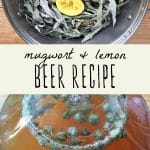
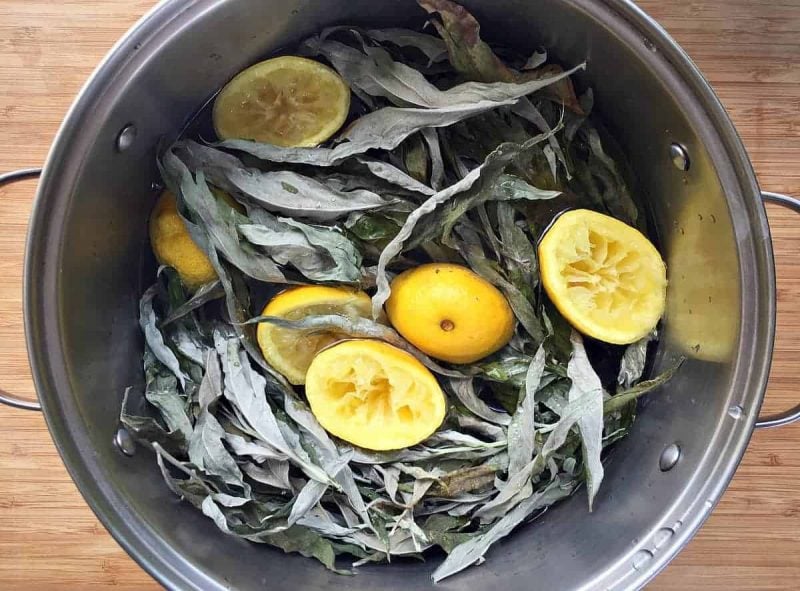
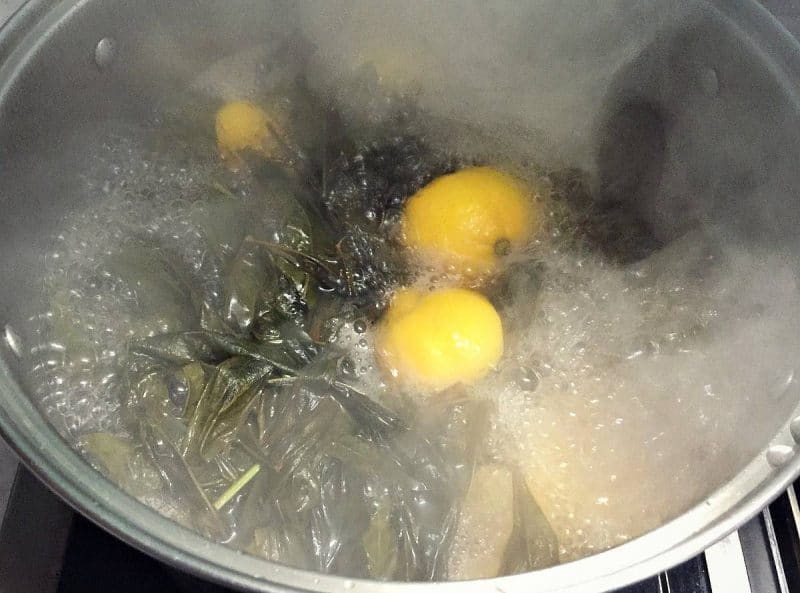
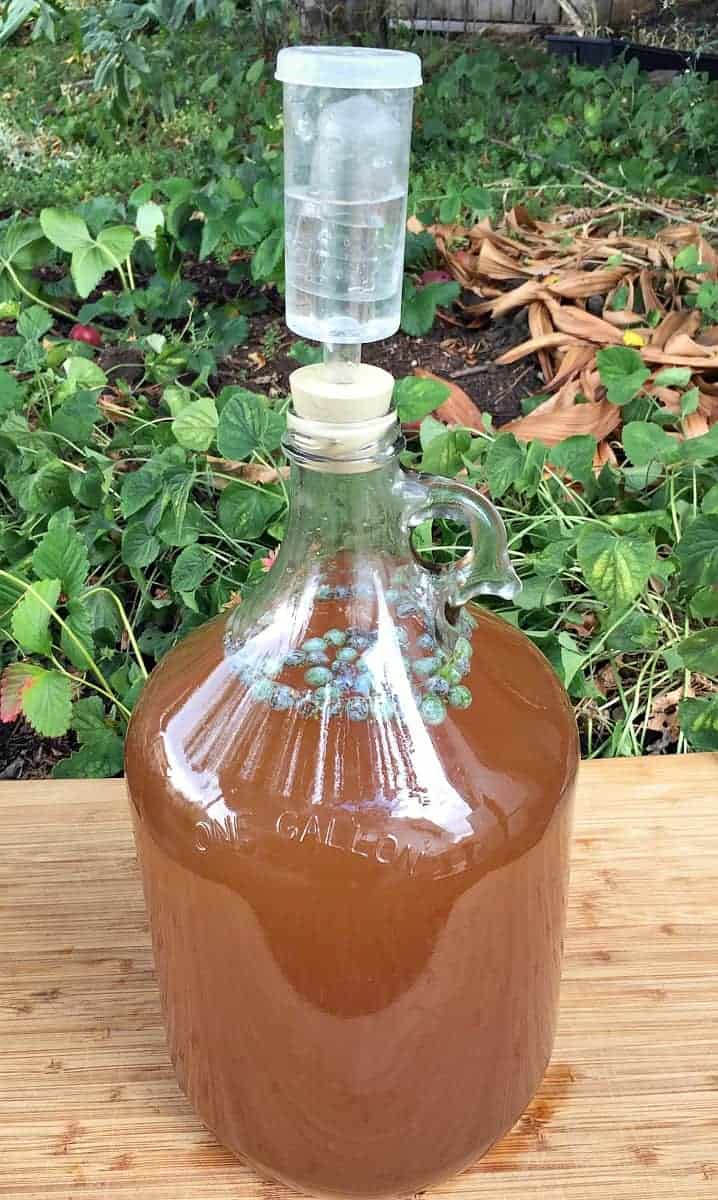
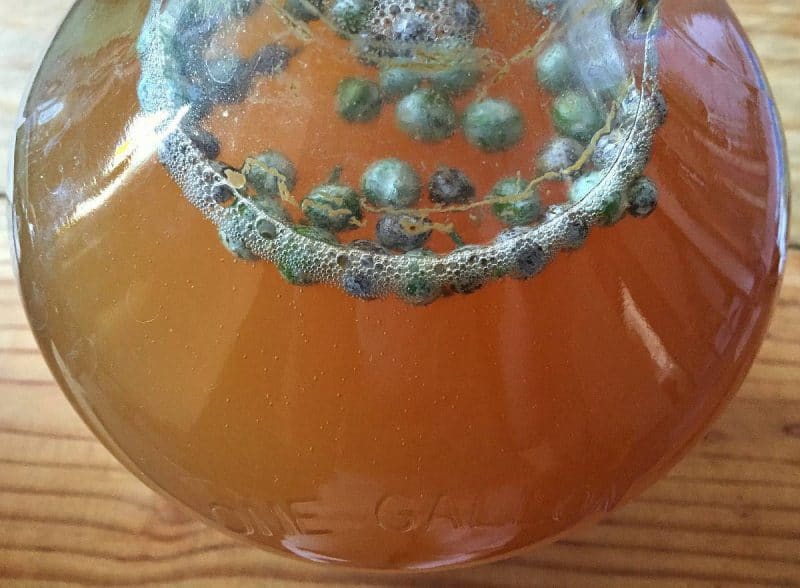
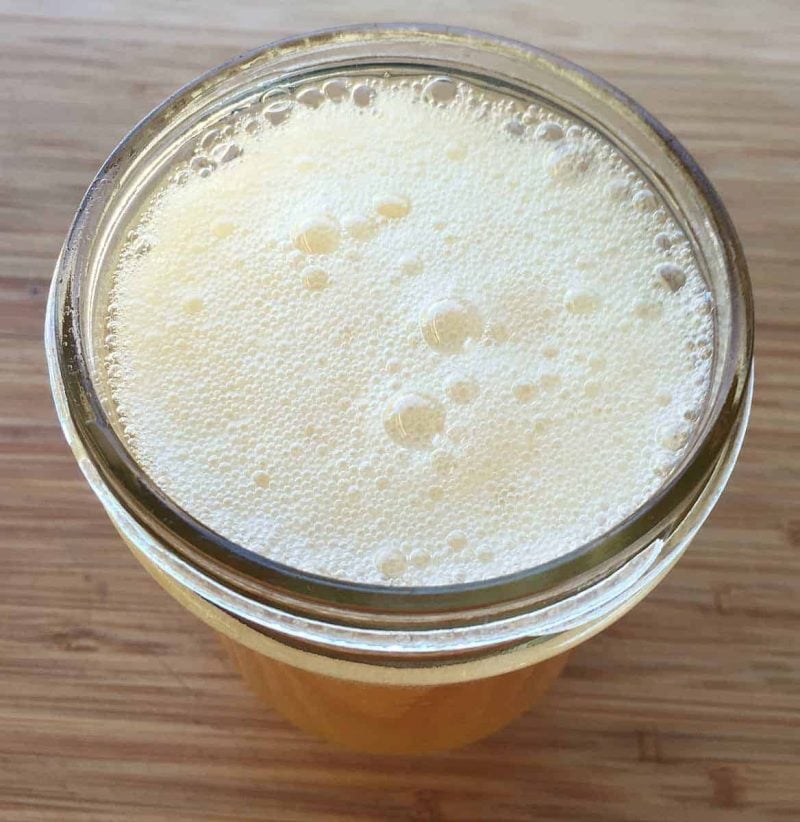
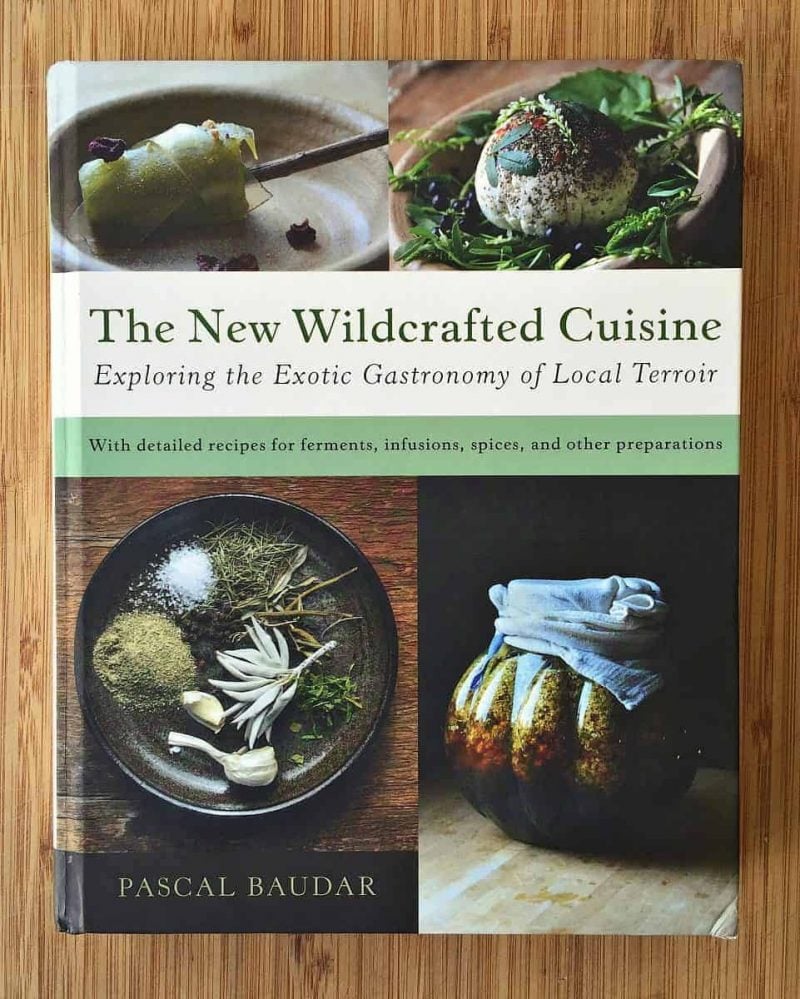
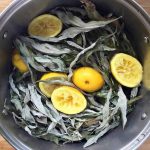

Thanks for this great recipe! I just bottled my first batch- I left it to ferment for 10 days- it tastes slightly alcoholic and still quite sweet- very tasty :)There was quite a bit of fermentation going on- the airlock was bubbling every 30 seconds for the first week and slowed down to 1.5 minutes this morning before bottling. It is already quite carbonated- will it continue to ferment in the bottles and should I be burping the bottles at all? I am really looking forward to the finished product!
Hi Rachel. If you siphoned your beer off the dead yeast, it shouldn’t continue to ferment in the bottle.
I made my first batch according to the directions (but with store yeast), I love it! I’m so excited, I never made beer before!! Now that that batch is done, I’m making another. I’m going to add some wood sorrel for some tang and some bee balm for more bitterness just to see what happens because this is my new favorite thing. Thank you for posting such a wonderful recipe!!!
Hi Eve! You’re so welcome. Let me know how your wood sorrel creation turns out!
Hi there!
Would you mind sharing what type of yeast and how much you used? I’d like to use store bought yeast but I am new to brewing.
Store bought yeast is not for brewing, unless you want your beer to taste like a loaf of bread. Check out Amazon or another homebrewing online retailer for different kinds of packets of yeast specific to the flavor profile you’re going for. For this recipe, I made a wild yeast starter, which you can find here. I haven’t tried this with a hone brewing yeast, so I can’t recommend one for you to try.
Hi there, could you use packaged yeast for this recipe instead of the Wild yeast starter? If so what type of yeast and what quantity would you recommend? Thanks so much
Lovely recipe, do you know the alcohol percent on say a 12 ounce serving?
Hi John. I didn’t measure the ABV, sorry!
How do you know when it is ready to drink? I’m new to brewing.
It’s typically ready in 3 to 4 weeks when your bottles are carbonated. You can tell it’s carbonated by gently swirling the bottle around. If by doing this, you stir up sediment from the bottom of your bottle, you know that the yeast is working on carbonating your beer.
Hi I’d like to know what size flip top bottle was used. I have 16oz flip tops and 350 mL I dont want them to explode. Maybe just the total amount of priming sugar needed for the gallon
I used 16oz flip top beer bottles. Make sure they’re for homebrewing and not decorative!
Hi, I love your recipes and website. Thanks for sharing! One question: is there a reason not to use fresh mugwort in this recipe?
You can absolutely use fresh mugwort. Normally with any dried versus fresh medicinal plant, you’d want to use more fresh, as dried is concentrated, but fresh mugwort has a really strong taste and volatile oils in tact … just use your judgement. Depending on the time of year and growing cycle, the fresh plant has different “strength” of taste … this is not a precise science. Use your sense of smell and feeling and trust your instincts!!!
It’s springtime and the mugwort is sprouting quickly. Can I use fresh mugwort instead of dried? How much for this recipe. Thank you!!
I want to know too!
1 cup of yeast? Could you please confirm that? It seems a bit much for packaged dry yeast. Is it 1 cup of liquid yeast being referenced?
Hi Christine, this recipe uses one cup of wild yeast starter. I updated the recipe to make it more clear with a link to the recipe for the starter. Hope that helps, and thanks for pointing it out!
I have been home brewing since 1990. I have no idea what mugwort is. I live in a desert area and do not think I could harvest some. Where could I get mugwort?
We have mugwart here in KY in our yard and garden. It is a VERY invasive plant that was here when we moved in. I have wondered if a previous owner planted it here. I tried for years to get rid of it by trying to get rid of the massive amount of roots, but it is impossible. We finally had it identified at the extension office (we had been calling it fern weed). When we researched it to see if we could use for something, we found a lot of warnings and not much positive info which is why I clicked on this link. We do not drink alcohol, but I wanted to see if there was some other information on mugwart… Because we have an endless supply! 😂
I know this is a late reply but you can eat it. In Asia it is used as a pot herb. you can steam it and put it in sweets. It is called yomogi inJapanese and you could find recipes. If you are into it, it can be used as a smudge cuz it is in the sage family. you can also use as incense or put it on a dream pillow as it is supposed to help licid dreaming. again, if you are into that kind of thing.
If I wanted to make 5 gallons, would i literally multiply everything by 5, i.e., 7 1/2 lbs sugar? Could malt extract replace any of the sugar? Thanks so much! Can’t wait to try it (Just harvested some mugwort!)
I’m on day 7 of fermentation and it’s still really going strong. I’m thinking that by day 10 it’ll still be pretty active. Should I wait until it’s done to bottle, or bottle it at day 10 and burp the bottles? BTW, the wort tasted delicious. I can’t wait to try the finished product.
Hi Kim, I would wait until it dies down a bit before bottling. This ferment can sometimes be quite active, and you don’t want any bottle explosions!
Hi Colleen,
Trying this recipe at the moment. Was there a need for burping the bottles at all? I am just trying to be weary of any explosions.
It’s not totally necessary, but I often do it just to be safe :)
If I wanted to make 5 gallons, would i literally multiply everything by 5, i.e., 7 1/2 lbs sugar? Could malt extract replace any of the sugar? Thanks so much! Can’t wait to try it (Just harvested some mugwort!)
Could wormwood be used instead of the mugwort? I have a big bush of wormwood and would prefer to use that if possible. Thanks!
Tried it and I like it!!!!! Very clean, fresh taste. Making another batch and I’m going to try grapefruit instead of lemons.
I’m confused about the amount of brown sugar: “1 1/4 (577 g) dark brown sugar” What is the measuring unit for 1 1/4? I can’t get 577g to correspond with 1 1/4 for another unit of measure. Thanks, I look forward to making some!!!!
Hey Chris, sorry about that! It should read 1 1/2 pounds, I must have inadvertently omitted that part. I edited the post, thanks for pointing that out!
I’ve been at home brewer since 2012, I really enjoy the craft side of home brewing, I’m really excited to give this recipe a try.
I made 3 gallons O.G. was 1.045. I waited a couple days after fermentation stopped to bottle. Gravity was 1.02 so the A.B.V. should be about 3%. I didn’t use enough priming sugar so it is kinda flat but it tastes great. Very refreshing on these warm cali summer days.
Could I use honey instead of brown sugar in this recipe? And at what ratio? Thanks!
You could for sure, and it would then be mead! If you are doing a wild ferment I would do about 1 pound of honey, but if you’re adding yeast you could do more like 2-3 pounds.
This looks like a lot of fun. I look forward to trying it.
looks yummy!
I’ve “brewed” kombucha and made wild ferments before, but I can’t wait to try my hand at beer, mead and wine!
I am psyched about this recipe. Would love to win the book. Thank you for the opportunity.